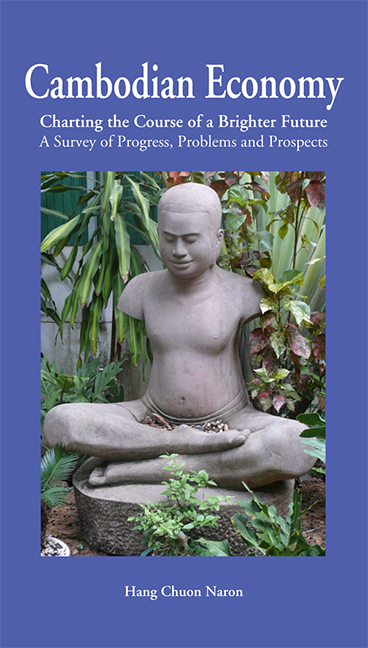 Cambodian Economy
Cambodian Economy from PART III - THE CHALLENGE OF MODERNIZING AGRICULTURE
Published online by Cambridge University Press: 21 October 2015
Landlessness
In 2004, half of rural households, or well over a million rural families, owned less than 0.5 ha of arable land. Because of the uneconomic size of the landholding, some farmers might have sold their land in order to take jobs in sectors outside of agriculture. In general, a family that owns between a half to three quarters of a ha of average-fertility cropland can earn an annual income of $300 to $400, provided that the rice yield is 2 tons a ha and the price of paddy is $200 a ton.
Arable land accounts for about 20% of the total area of the country. A reduction in the average size of land plots is observed as the number of families increases due to demographic growth. 90% of the plots are less than 0.5 ha and 75% of farms are less than 1.0 ha.
According to a study by Oxfam (2006), landless farmers account for 25% of rural households, while the Socio-economic Survey of Cambodia (SESC-2003-04), which is more representative, identified 25% of the population in the agricultural and non-agricultural sectors as being landless. A survey of farming households suggested that 12% of farmers were landless (Biddulph 2000, Biddulph 2004).
It is obvious that the concentration of land wealth strengthened and accelerated between 1999 and 2004. The SESC-2003-04 found that in 2004, households owning less than 0.5 ha account for only 5.4% of arable land, while those who hold more than 3 ha own 48% of the land. It is estimated that 10% of landowners own 40% of the land.
A growing concentration of land could allow agricultural modernization through the improvement of economies of scale and the use of advanced technologies. However, the secondary and tertiary sectors in Cambodia, despite the robust growth of tourism, textile exports, and construction, have no obvious capacity to absorb the rural exodus of great magnitude, at least in the medium term. Consequently, the growing concentration of land could result in stubborn rural poverty and growing unrest in the urban sector.
To save this book to your Kindle, first ensure [email protected] is added to your Approved Personal Document E-mail List under your Personal Document Settings on the Manage Your Content and Devices page of your Amazon account. Then enter the ‘name’ part of your Kindle email address below. Find out more about saving to your Kindle.
Note you can select to save to either the @free.kindle.com or @kindle.com variations. ‘@free.kindle.com’ emails are free but can only be saved to your device when it is connected to wi-fi. ‘@kindle.com’ emails can be delivered even when you are not connected to wi-fi, but note that service fees apply.
Find out more about the Kindle Personal Document Service.
To save content items to your account, please confirm that you agree to abide by our usage policies. If this is the first time you use this feature, you will be asked to authorise Cambridge Core to connect with your account. Find out more about saving content to Dropbox.
To save content items to your account, please confirm that you agree to abide by our usage policies. If this is the first time you use this feature, you will be asked to authorise Cambridge Core to connect with your account. Find out more about saving content to Google Drive.